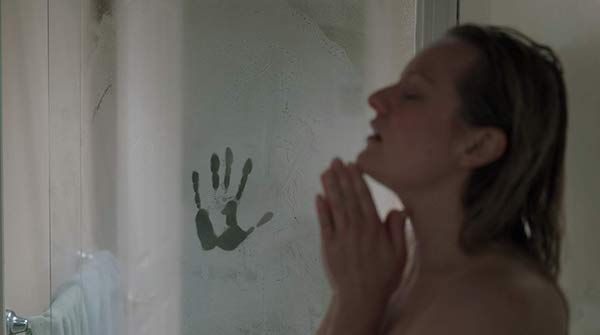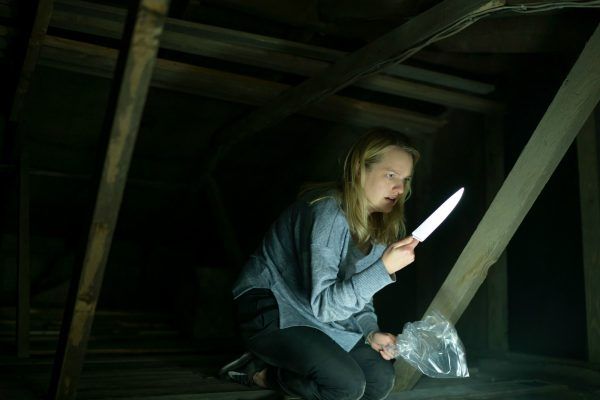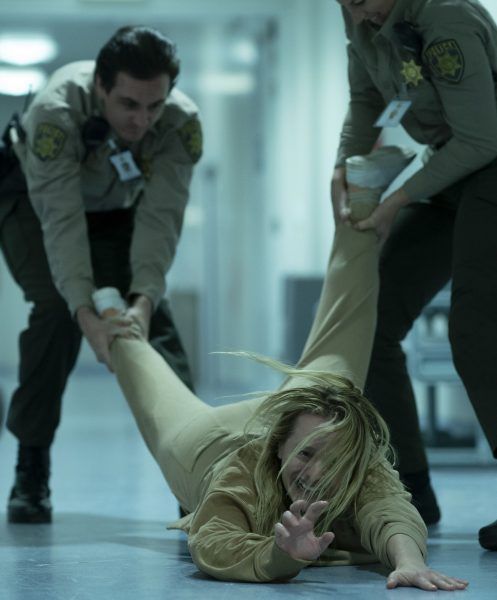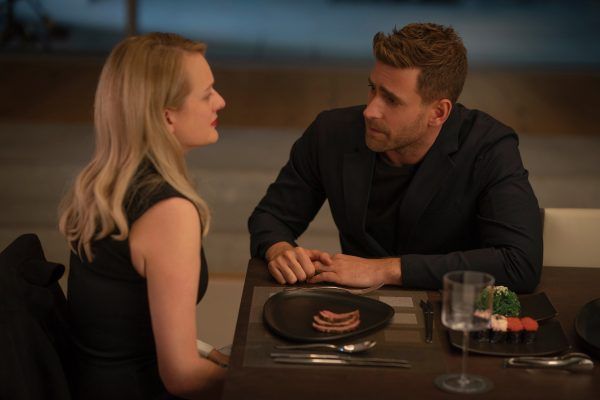"One night, I was sitting, and I was thinking about how to leave Adrian. I was planning the whole thing in my mind. And he was staring at me. Studying me. And without me saying a single word, he said that I could never leave him. That wherever I went, he would find me. That he would walk right up to me and I wouldn’t be able to see him. But that he would leave me a sign so that I’d know he was there."
Horror film cinematography using first-person vantage points to align with either its heroes or (more often) its villains is nothing new. Michael Powell's Peeping Tom, released in 1960, features a serial killer who films his crimes with a camera, and Powell often switches to his real-time captured footage. John Carpenter's Halloween of course opens with one of the great and most influential first-person genre tracking shots of all time. And the found footage subgenre of horror makes this technique a fundamental building block. But in all my years of watching and loving horror cinema, I'm not sure I've ever seen "the camera" weaponized in such simple, dread-inducing, and horrifyingly satisfying ways as in 2020's The Invisible Man.
Warning: Light spoilers of The Invisible Man are sure to follow.
Most screen depictions of The Man Whomst Is Invisible involve him as our sympathetic antihero -- think the iconography of "bandages, sunglasses, hat, and coat," as established by James Whale's 1933 classic. He's a genius tortured by his monstrosity, a figure coded as a villain we are challenged to identify with. Not so with Leigh Whannell's prescient, incendiary take. His invisible man, as played with single-minded intensity and ickiness by Oliver Jackson-Cohen, is purely our villain. Our hero, whom we want desperately to succeed, is his victim, played to perfection by Elisabeth Moss. Cecilia Kass (nicknamed Cee, as in "see"), was trapped in a controlling, abusive relationship with the powerful and manipulating scientist known as Adrian Griffin (his field of science? Optics). When Cee finally escapes from Griffin, she later finds out he committed suicide. Or did he? Is he, in fact, putting his research to use, terrorizing and trying to control Cee without being seen?
The rest of the film's engines of terror alternate between quiet, paranoid, anxiety-inducing fakeouts (is an invisible man stalking me?) and increasingly visceral moments of blunt trauma (yes, an invisible man is stalking me). All of these are captured disquietingly and immersively by Whannell and his DP Stefan Duscio, who also lensed Whannell's previous genre masterpiece Upgrade. Together, these two turn their camera into an omniscient, point-of-view character within the film. Sometimes it represents Griffin's point of view. Sometimes it represents an unknown, uncaring, malevolent "visual narrator," eager to rub in our faces how both alone and non-alone Cee is. And oftentimes, the camera will exist liminally within these two points of views, putting both Cee and us always on a razor's edge. If, while watching this film, you think to yourself, "That's unfair!" about a situation Cee is put in, it's because Whannell and Duscio have sharpened this visual vocabulary to an inhumanely human level.
The introductory sequence, a gripping showpiece of quiet suspense, heroic ingenuity, and defining of stakes regarding our villain, finds Cee attempting to escape the literal clutches of Griffin and his sleek, isolated compound. It introduces the first idea of the camera being our unflinching narrator, establishing what I might call the signature shot of The Invisible Man: Pan To Nothing, Pan Back. As we watch Cee try desperately to pack everything she needs up, the camera pans to a hallway. There is literally nothing in this hallway. Just darkness. But we hang out on it for some time. And then, almost as a cruel joke, the camera just pans back to Cee, who hasn't noticed a thing. This narrator, this observer of Cee's plight, is taunting us with the idea that someone might be getting her, using our expectations against us, placing us in the same psychological state of being as Cee. Whannell and Duscio use this shot several times throughout the film, most after we know Griffin is on the hunt, but this first one struck me as the most aggressively effective. He's literally not an invisible man yet, and I'm already scared of everything. Screw you, camera narrator!
Cee knows, deep in her bones, she's dealing with an actual human being after her. Or, at least she thinks she does. Because everyone around her, from her sister Harriet Dyer to her best friend Aldis Hodge to even Griffin's brother Michael Dorman, insists that these episodes are psychosomatic. Griffin's abusive acts of control warped Cee's perceptions, both exterior and interior. The only way to not let him in? Accept that he's truly gone. It's a tempting proposition for Cee, and we all know the folks telling this to her have the best intentions at heart (even Griffin's brother, at least for the first couple acts). But because we know the truth, it ultimately adds to the mix of her mental gaslighting turned physical. And when the camera shifts cruelly between an invisible Griffin's point of view and an omniscient narrator's point of view, generating a new, "fluid" point of view, it turns the screws of this damaging psychological warfare tighter.
In my opinion, the "attic" sequence is the classically scariest of the picture, and speaks to this "shifting vantage point" perfectly. After Cee's friend and his daughter (Storm Reid) abruptly leave the house when Griffin hits the daughter to make it look like Cee did, Cee takes it upon herself to call Griffin's phone (after a conversation cross-cut with standard coverage, except Moss' scene partner is literally nothing). Wouldn't you know it, the phone vibrates. From where? The attic -- and as we realize this, the camera shifts to a POV directly above Cee. She looks straight up, and we zoom way back, making her smaller as she stares at... well, what? The possibility of Griffin being there? Griffin explicitly being there? The narrator-camera reminding us how small she is? This shot is all of these things simultaneously, becoming none of those things singularly -- a stew of potential terrors.
The sequence ends with a canny reversal of this first camera move: Right before Cee is about to pour paint on what she thinks is Griffin standing on the attic ladder, Whannell and Duscio cut to an extreme wide of Cee's face, frozen in the attic, the coloring starkly pale compared to the warmth of the house around her. She's staring straight at the camera, at what she (and we) believe to be Griffin. Then we cut back behind her, she chucks the paint forward, and WHAM. Griffin is right there. Absolutely not as far away as this previous shot just was. The camera, in order to conjure as much dread as possible, tricked us into thinking it was Griffin, when it fact it was from Griffin's angle, but not his depth. Both, nothing, everything -- when the camera shifts POVs abruptly, we all suffer.
As for when we know explicitly (or at least as explicitly as possible) that the camera is aligned with Griffin's point of view? It usually results in the toughest, hardest, most action-leaning scare sequences, the hospital strike being a great example. After Cee is locked away in a mental health institution for "killing" her sister (really Griffin, of course), she finds out she is, indeed, pregnant with Griffin's baby. She sneaks a pen off Griffin's brother, and stages a suicide attempt to lure Griffin out of "hiding." And when he "shows up," shit hits the fan. Cee stabs him, and we see his invisible suit flicker into existence for the longest amount of time thus far. When guards show up at Cee's door and Griffin has to fight his way out, Whannell and Duscio stage his brutal brawl through the hospital's series of guard in a Griffin-aligning oner, corrupting and twisting a previous visual move they established in Upgrade.
In that film, about a man who installs a computer operating system of sorts in his body to fearsome results (hey, another malevolent invisible force!), Whannell and Duscio locked off the camera to stay stable on the hero's face, as he (the computer) plowed his way through all the baddies. The audience aligned directly with him, while his victims kinetically fell all over the place. In The Invisible Man, the duo flips everything. The camera stays locked off and stable on the victims' bodies and faces. Because we don't see a body performing all the attacks, we just see these poor guards' agonies rendered in agonizing detail. As such, it's made implicit that we are aligning with Griffin, serving as his eyes as he dispatches one body before swiftly slithering (communicated through aggressive, "first-person" pushes across the floor) to the next one. One key moment in this set piece finds a guard pulling a gun on Cee. "He's behind you!" she screams at him, over and over. As she does so, the camera (Griffin) slowly circles around the guard until the camera (Griffin) is, indeed, behind the guard, making Cee's protestations grimly literal.
Beyond the extratextual filmmaking tactics used to weaponize "the camera," Whannell makes damn sure we know that the world of The Invisible Man finds any and all types of "cameras" to be evil characters in of themselves. When Cee first tries to escape the compound, we watch her grapple with shutting off the security cameras and observant tablets. Upon her escape, one of the first things we see her do is look up how to keep people from spying on her through her computer's webcam. Cee discovers Griffin's phone in the attic, and realizes he's been taking pictures of her and her friends sleeping. Hell, Griffin's invisible suit is literally a bunch of cameras put together.
And how does Cee finally win? By taking advantage of the inherent limitations of cameras, of course. She dons Griffin's suit of cameras, makes it look like Griffin has grabbed a knife and killed himself on the compound's security camera (learning from his restaurant tactic), then rushes back in as herself, acting as though she's surprised and terrified. But the moment she knows she's out of the camera's view? Her face and countenance change. She's been taunted and terrorized unfairly by millions of cameras, diegetic and otherwise, throughout the film. She's learned their tricks. And she was ready to, just as these cameras did to her, weaponize them.
Griffin left her a series of signs, alright. But at the end of the day, a sign's meaning is only as powerful as the person who makes it.
The Invisible Man is now available to own on 4K Blu-ray, Blu-ray, and Digital. For more about the film, check out our interview with Hodge.





